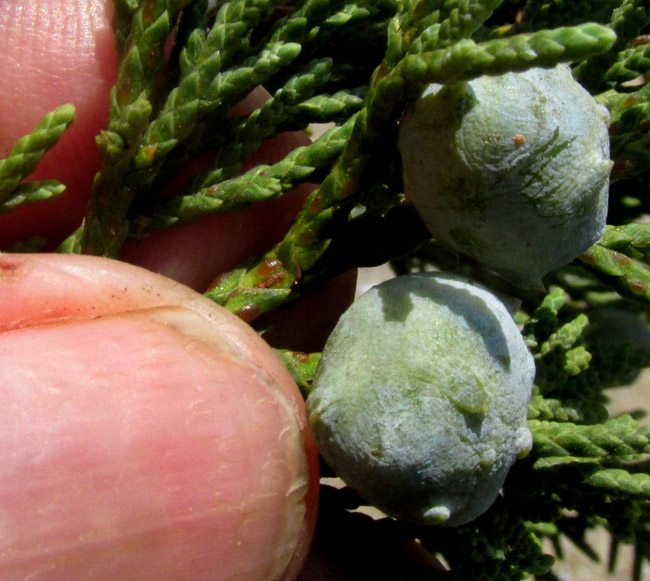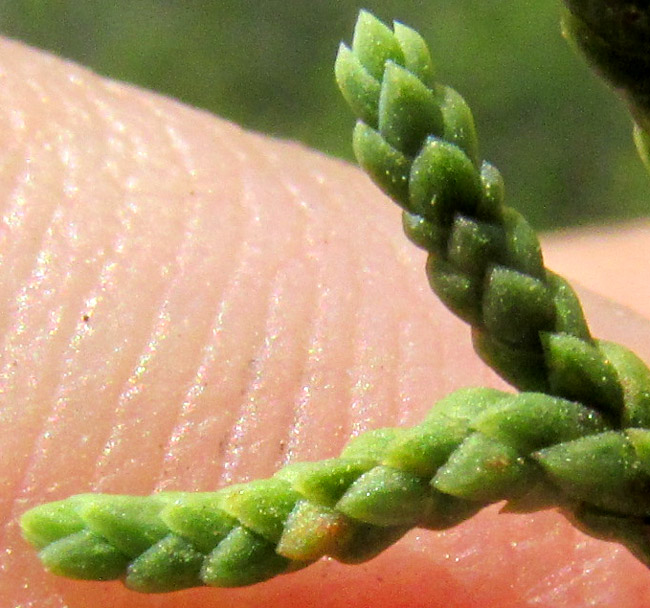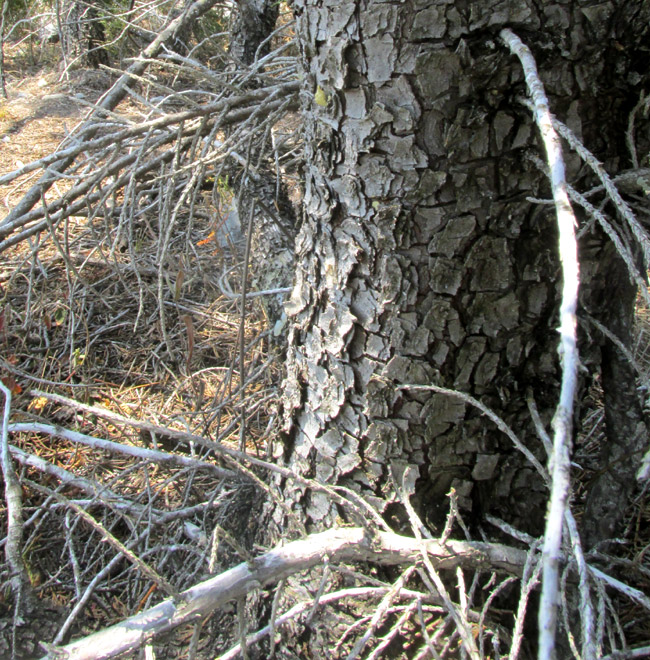Excerpts from Jim Conrad's
Naturalist Newsletter
entry from field notes dated May 4, 2023, taken about 150m uphill on NE-facing slope, above intersection of road from Hwy 120 to San Joaquín, with road to El Doctor; juniper and pine forest on limestone bedrock; elevation ±2425m (7950 ft); Eastern Sierra Madre mountains of east-central Querétaro state, MÉXICO, (N20.88°, W99.62°)
ALLIGATOR JUNIPER

The above branch of a juniper tree about 5m tall (15ft) was loaded with silvery-frosted seed cones. They're cones instead of fruits because junipers are gymnosperms, like pines and spruces, and gymnosperms don't produce fruits. They're specified as seed cones because gymnosperms also produce different looking, pollen producing male cones.

Above, notice that something has scratched the cone at the top, right, removing some of the silvery bloom. Botanists refer to the silveriness as glaucescence, and it can be rubbed off to reveal the green cone surface below. I'm guessing that glaucescence is an adaptation for reflecting this area's intense, high-elevation sunlight away from the cone and the fragile genetic material in the seeds.
My thumbnail is so prominent in the above photo because in juniper identification cone diameter can be a distinctive feature. These cones seemed larger than those on most juniper species I've seen. The thumbnail is helpful because I know that the tip shown in the picture is 14mm across, but the tip in the picture on my laptop screen is 64mm across. The cone on my screen is 51mm wide, so using algebraic "ratio and proportion" the cone can be calculated to be a little over 11mm in diameter. Cones of the Ashe Juniper we found so abundant in southwestern Texas and northern Mexico are no wider than 9mm, so our cones' size alone eliminates that species as a possibility.

Even the scale-like leaves show important field marks. Besides their shape and size, their margins are "smooth" -- not bearing tiny teeth. That separates this species from the Weeping Junipers that dominate in certain high elevations in this area, where fog is more likely to form. Weeping Junipers also produce conspicuously drooping branches.

However, the above photo shows the most obvious feature separating our current species from both the Ashe and Weeping Junipers. Bark on those species manifests as long, fibrous strips that exfoliate, or peel off. Our tree's bark forms rectangular plates, "like alligator skin" they say.
In our region of upland, central Mexico, if you have a juniper species developing seed-bearing cones with a diameter greater than 9mm (11/32 inch), and the tree's bark is blocky as shown above, you have JUNIPERUS DEPPEANA. In English the tree usually is called Alligator Juniper, referring to the bark. The species owes its English name to its presence in the dry, upland parts of the US states of Arizona, New Mexico and Texas. However, most of Alligator Juniper's distribution lies in upland Mexico, south to Oaxaca.
Locals cut the trees for firewood and fenceposts, plus birds and mammals feed on the seed cones.
The online Atlas de las Plantas de la Medicina Tradicional Mexicana, which calls it sabino, tells us that in Mexico the main medicinal use of Alligator Juniper is for gynecological disorders, such as normalizing the menstrual cycle and stopping the bleeding associated with giving birth. While the tree's branches are boiled in water, the vapors are believed to counteract the "coldness in the womb" after the birth. The plant also is recommended for colds, rheumatism, neuralgia, dandruff, and to cure the cultural disease called mal aire, or "bad air," and for cleansing the spirit.